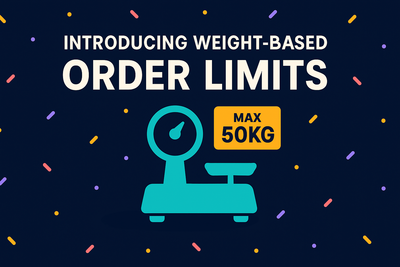Ever struggled with orders becoming too heavy, unexpectedly pushing shipping costs beyond budget? Soon, weight-based order limits will be available on DC Order Limits, providing a practical way to maintain control over shipping expenses.
Weight-based order limits allow merchants to set a minimum or maximum weight for customer orders. This ensures that individual shipments remain within manageable sizes, significantly reducing unexpected freight charges and simplifying logistics.
What are weight-based order limits and why do they make sense?
Weight-based limits place a minimum or maximum weight limit on customer orders. Setting these limits can easily prevent orders from exceeding standard shipping thresholds. Without clear boundaries, even a few extra kilograms can lead to:
- Unexpectedly high shipping charges
- Increased risk of damage during transit
- Inefficient handling and logistics
Applying weight-based limits ensures each order stays within the shipping parameters that are best fit for your operations.
Why do weight-based limits matter?
Weight-based limits are not just about cost control, they support a more efficient and consistent fulfillment process. By defining a reasonable weight boundary, merchants can:
- Reduce shipping expenses by avoiding oversized shipments
- Prevent delays caused by packaging or carrier complications
- Ensure products are packed and shipped safely, minimizing damage risk
- Set clearer expectations for customers around shipping methods and timelines
- Improve customer satisfaction by providing reliable, well-managed delivery experiences
Together, these benefits help merchants protect their margins, reduce fulfillment strain, and deliver a more professional experience to customers.

Example 1: Furniture store shipping optimization
An online furniture retailer faces logistical challenges when customers order multiple large items simultaneously. Orders frequently surpass weight thresholds, triggering costly freight charges.
By implementing a weight-based limit, such as a maximum of 50kg per order, merchants can keep shipments within parcel-size ranges, avoiding freight charges and simplifying fulfillment.
Example 2: Bulk goods supplier combining weight-based limits with market eligibility
Weight-based limits become even more effective when paired with market eligibility rules. Merchants can apply different weight requirements to specific regions, helping them adapt to varying shipping costs and logistical constraints.
A bulk goods supplier, shipping both domestically and internationally, struggled to fulfill small international orders profitably. Shipping anything under 10kg to certain regions was inefficient and costly, often requiring special handling or carriers. To address this, the supplier created a rule that enforced a 10kg minimum order weight for customers in those high-cost areas, while allowing more flexible order sizes for local buyers.
By applying market-specific weight minimums, the business maintained healthy margins on international shipments without compromising the customer experience elsewhere.
How to set up weight-based order limits (coming soon)
Soon, setting up weight-based order limits will be straightforward:
- Navigate to create a new order limit rule
- Specify the desired maximum weight per order
- Select the products and customer segments the rule should apply to
- Activate the rule to apply either at checkout, at cart or both
Once configured, weight-based limits automatically manage order sizes, ensuring shipping remains cost-effective and efficient.
With the introduction of weight-based order limits, merchants will soon have a new, effective tool to optimize shipping processes and protect profitability.









